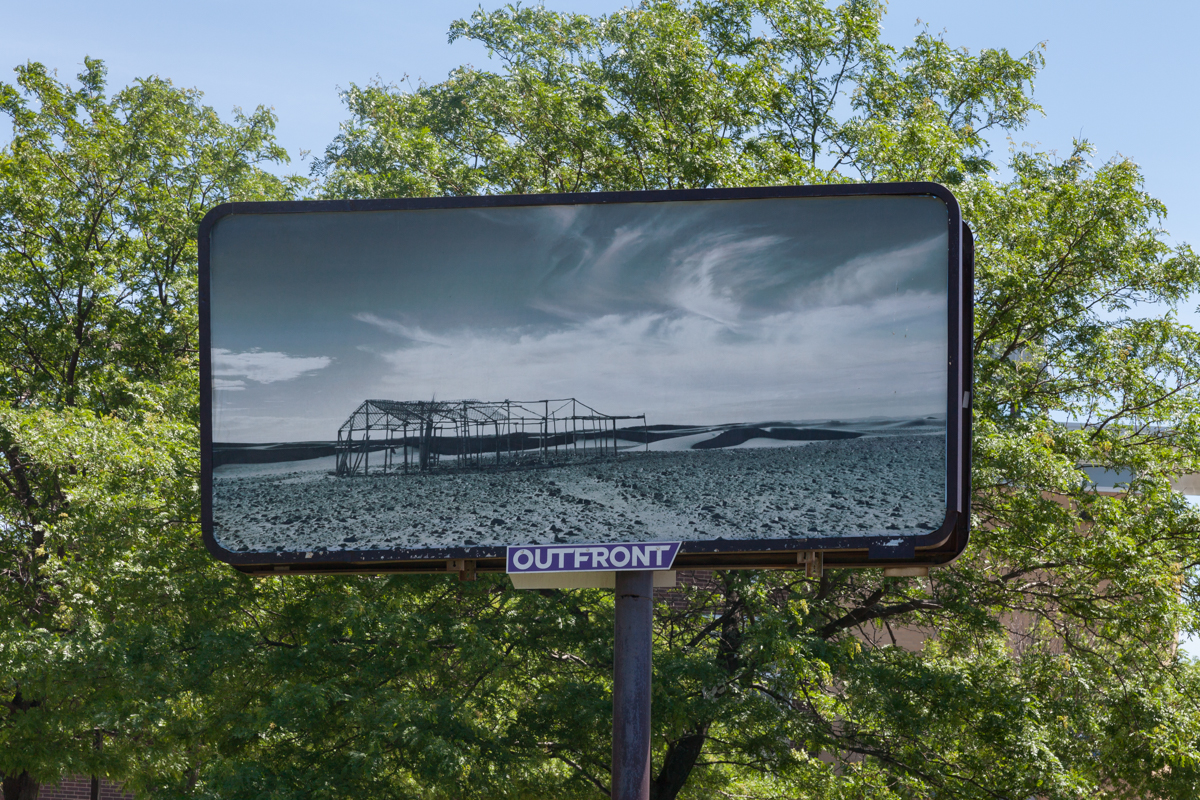
The Black Athena Collective, Assemblage, Billboard located at 1010 E. 43rd Street, Chicago, June 6 – July 11, 2016, as part of In the beginning, sometimes I left messages in the street, curated by Allison Glenn.
In the spring of 2016, Allison Glenn curated In the beginning, sometimes I left messages in the street, an exhibition that featured eleven artists and artist collectives who installed works at ten different sites across the city of Chicago from Woodlawn to Wicker Park; these included billboard interventions, performances, and public installations. With a title inspired by the first sentence in David Markson’s novel, Wittgenstein’s Mistress, the exhibition highlighted structures of power that organize everyday life and cultural events and subverted their effects. A long-time Chicago resident, Glenn recently relocated to New Orleans to join the organizing team of the Prospect New Orleans Triennial. She is also working on a 2018 exhibition, Out of Easy Reach, in collaboration with the DePaul Art Museum, Stony Island Arts Bank, and Gallery 400 in Chicago.
Caroline Picard: Can you talk about what inspired you to use billboards as a site for curatorial or artistic intervention in In the beginning, sometimes I left messages in the street?
Allison Glenn: I am passionate about employing modes of display to shift how audiences experience contemporary artworks; I believe such shifts have the propensity to expand the way we view and think about the world.
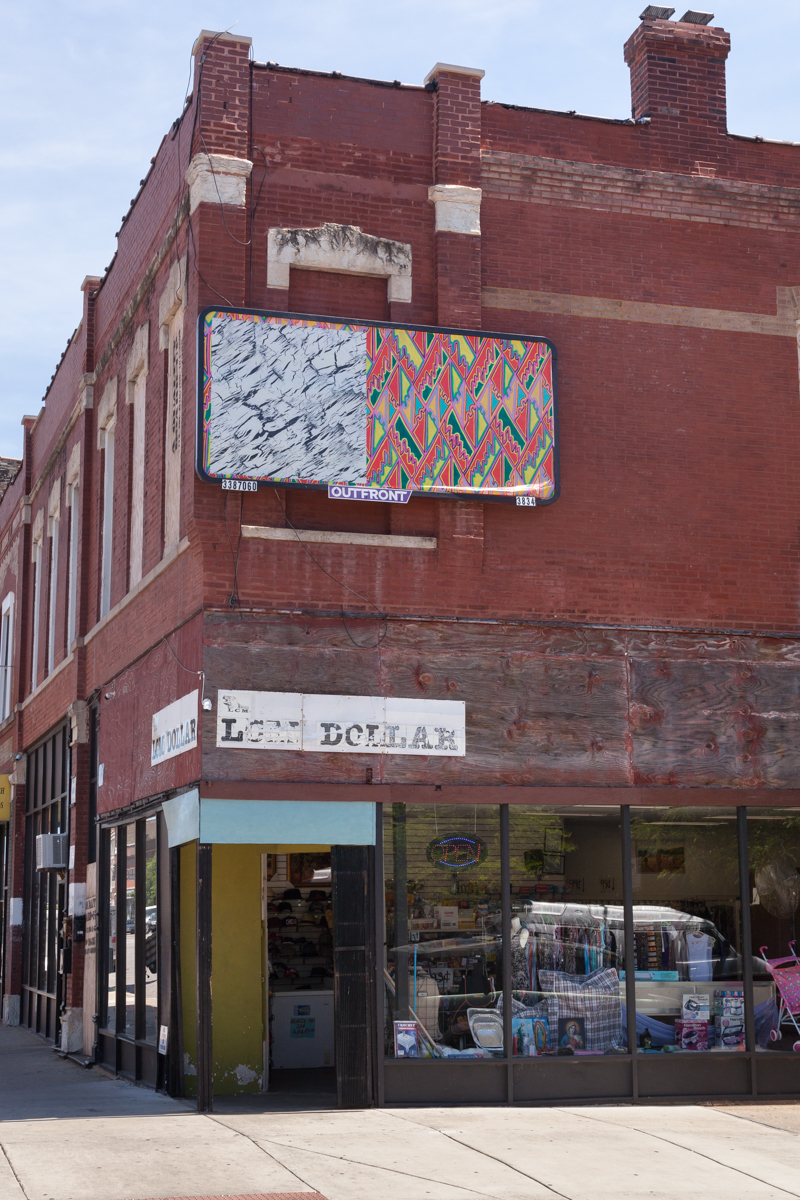
Lisa Alvarado, Untitled, Billboard located at 2657 W. North Avenue, Chicago, June 6 – July 11, 2016, as part of In the beginning, sometimes I left messages in the street, curated by Allison Glenn.
CP: How so?
AG: Addressing site specificity opens up a different set of parameters that have been intriguing for me, both in my past and current work. While I was the director of Monique Meloche Gallery, I began a public-art project called off the wall that featured the work of artists on six different bus benches in Chicago’s Wicker Park and Bucktown neighborhoods. The project debuted in 2014 with Hank Willis Thomas, and in 2015 it featured the work of Joel Ross. Developing this project and its funding allowed me to try out ideas I had been mulling over for a larger billboard project. I was excited about the bus benches but wanted to dig deeper conceptually, alongside an interest in physically expanding the area the exhibition covered.
CP: What made you specifically interested in the site of public advertisement? Were there art-historical precedents that inspired you?
AG: I looked to projects like Adrian Piper’s Mythic Being, specifically the advertisements she took out in the Village Voice in the 1970s, and the way ACT-UP used billboards during the 1980s AIDS crisis. The billboards I used for In the beginning, sometimes I left messages in the street—like many other forms of advertisement—convey demographic information that companies use to target specific audiences. I wanted to subvert this very clearly and directly, by presenting artists and artworks that spoke to or questioned the billboards themselves or the setting in which the billboards were situated.
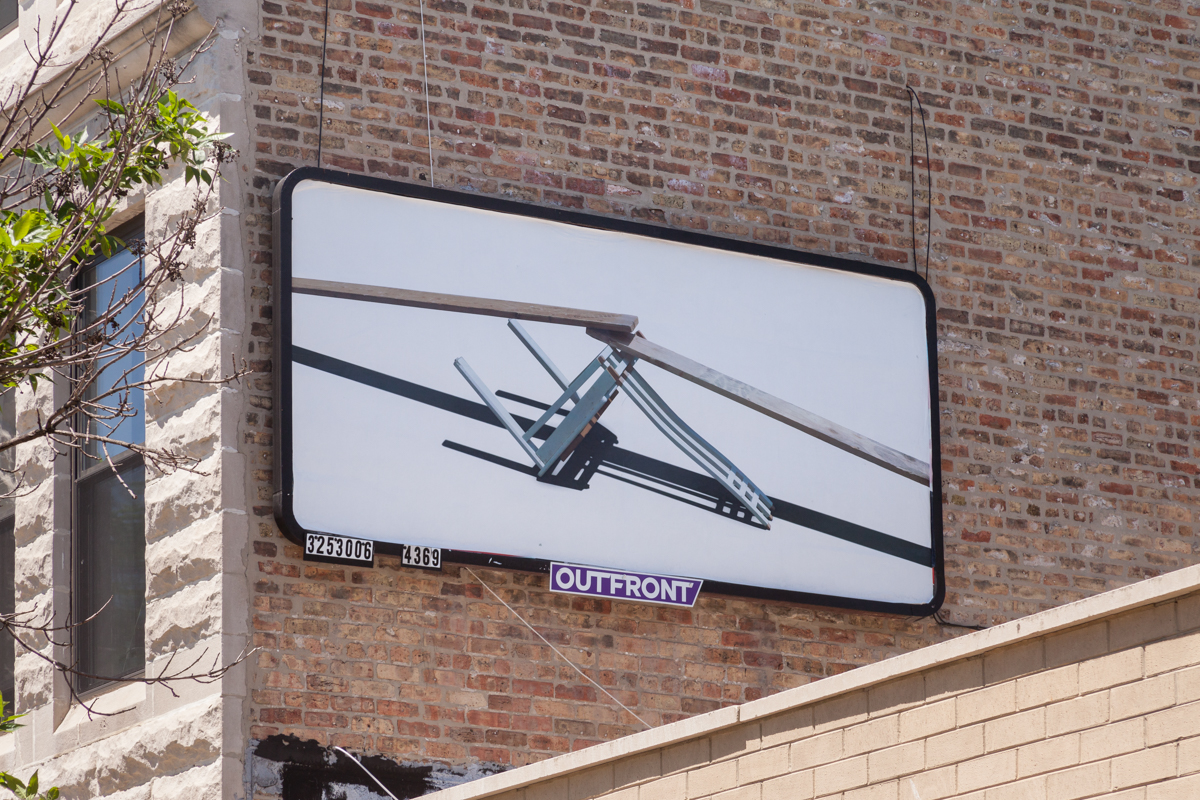
Assaf Evron, Chlevnov Street Do Not Park, Billboard located at 2540 W. Division Street, Chicago, June 6 – July 11, 2016, as part of In the beginning, sometimes I left messages in the street, curated by Allison Glenn.
CP: Museum administrators and funders, for instance, often worry about how to make contemporary art more accessible. In my experience, those discussions usually focus on how to get people living in distant parts of the city or suburbs into the museums: how to get them to travel there and then engage with the museum format. What strikes me about your exhibition is that you were able to use the vernacular advertising platform to bring art to an audience, allowing them to view it on their own terms. Does this seem like an overly romantic interpretation?
AG: Ha! If we’re not all romantics in this field, then what are we? I am hesitant to couch this project in the idea that I was bringing art to an audience but would rather say that I was challenging myself to think about what it really meant to work toward inclusivity, access, and equity in my curatorial practice. To position the work of artists whom I admire and respect in neighborhoods of a city that I love was an opportunity to pay homage to the physicality of Chicago and her neighborhoods. Because of where the work was placed, I was able to have different conversations with various audiences. With a changing audience was an opportunity to work with a certain central thesis and set parameters. It was also an opportunity to create a cartography of the city through my eyes.
CP: You also curated site-specific performances, sculptures, and sound into the show. How did those elements play off one another? Were there specific tensions or nuances between artworks and locations that stood out?
AG: The billboard that was chosen for the Black Athena Collective, a collaborative composed of the artists Heba Y. Amin and Dawit L. Petros, was located at 1130 West 43rd Street, on the strip of 43rd that is memorialized with the name “Honorary Muddy Waters Drive.” Assemblage (2016) is a black-and-white photographic image of a simple nomadic structure in the center of a sparse desert landscape. The placement of the photograph onto a billboard in the middle of a gorgeous bucolic landscape on the South Side of Chicago provokes dialogue about nomadic structures, migration, and diaspora so appropriate to the landscape of this neighborhood.
The theoretical and physical manifestations of bodies within public space so thoughtfully articulated by Amin and Petros were definitely considerations made in UNTITLED (OFFERINGS) (2016), a performance by Ayanah Moor and Jamila Raegan, with Krista Franklin and Anthony Williams. Through movement, song, and poetry, UNTITLED (OFFERINGS) provided a space for memorializing and self-care in this tumultuous time. This poignant moment of collective reimagining of bodies and public space came at the moment that much of the world learned of the tragic events at the Pulse nightclub in Orlando, Florida, on June 12, 2016.
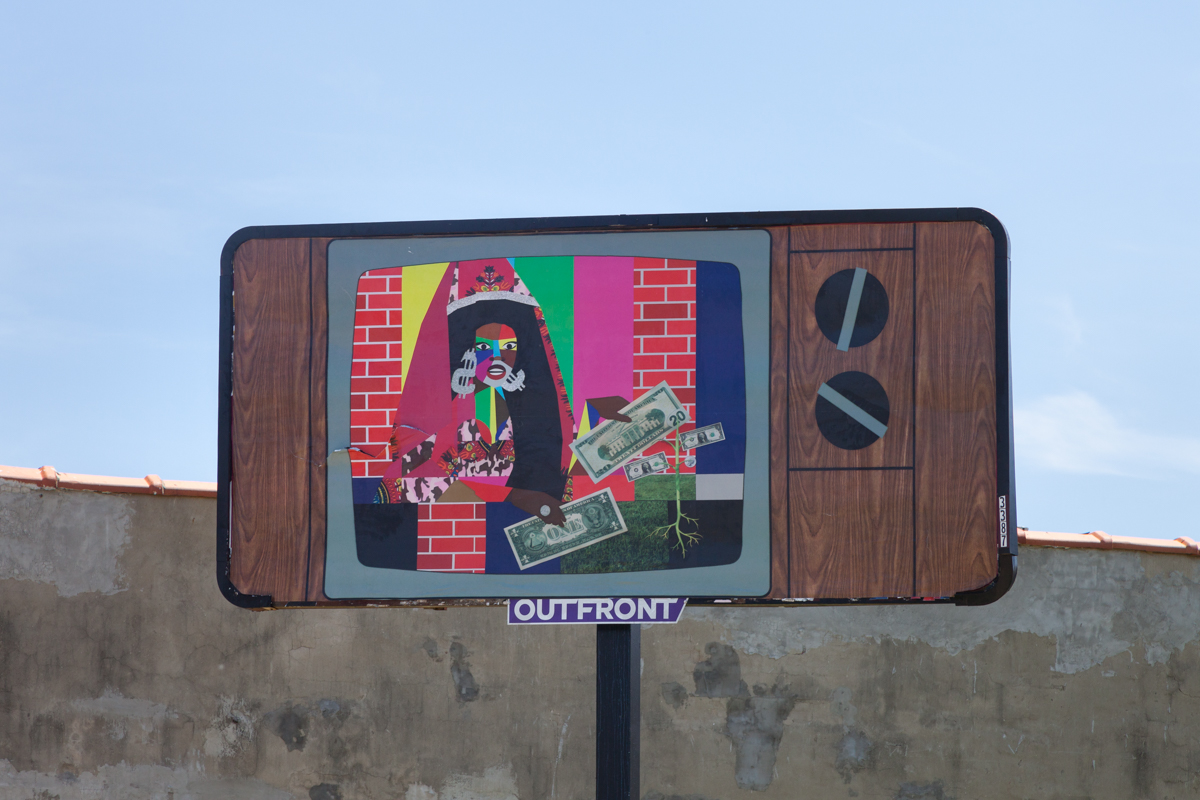
Derrick Adams, Free, Black and 21, Billboard located at 2841 W. Madison Street, Chicago, June 6 – July 11, 2016, as part of In the beginning, sometimes I left messages in the street, curated by Allison Glenn.
CP: The question of time strikes me. Museum structures tend to espouse an aura of timelessness: the objects contained within them don’t change, which suggests that the power structure that brought all of those objects together is also stable. By producing an exhibition outdoors and at different places in the city, you were able to acknowledge time differently. Not only did it take time for viewers to travel to these different sites but also the billboard is seen as a temporary platform that is constructed for a campaign of a moment.
AG: Yes, time was a huge factor. On the opening day, I remember getting off the train at the California stop on the Green Line with Derrick Adams and others. Derrick was talking about how this was his first train ride in Chicago, and we were heading to his billboard, which was located at 2841 West Madison Avenue.
I quickly looked at my phone to make sure we were staying on schedule to arrive at the West 18th Street and South Paulina Avenue plaza for a performance that was scheduled for that afternoon, and I noticed a New York Times alert of the tragic shooting at Pulse. Then information just kept flooding in, and by the time we got to the plaza, the day felt heavier, more melancholic than it had begun.
Through poetry, performance, dance, song, and other participatory movement, Moor, Raegan, Franklin, and Williams offered a moment of repose: an opportunity to pause and consider the radicality of self-care during this tumultuous time. As we stood on that plaza at 18th and Paulina, the depth of their project statement became so much more palpable: “Recent incidents of police violence and misconduct have been flooding digital and print media. The proliferation of graphic images of black trauma and death inspire call to action and protest just as it highlights the importance of gestures of memorial and self-care.”

Faheem Majeed, FREE DUSABLE, Billboard located at 207 N. Kedzie Street, Chicago, as part of In the beginning, sometimes I left messages in the street, curated by Allison Glenn.
CP: What was it about the “materiality of the built environment” that you were trying to get at? Were you specifically interested in the place-ness of Chicago? Why?
AG: There is such a love of place in Chicago. Whether from the South Side, North Side, West Side, or East Side, Chicagoans feel a strong and sometimes emotional connection to their neighborhoods. What this means of course is that Chicagoans also feel very strong emotions about neighborhoods that are not their own, and stigmas have developed over time about what and who should be where (surely with assistance from policy making on the federal and municipal levels). One of the main goals of the project was to provoke audiences to visit neighborhoods that they might not otherwise and, inversely, position works of art within spaces where one might not normally look. I also wanted to highlight other arts organizations that were engaging in similar programming. Partnering with the teams at Filmfront, ACRE (Artists’ Cooperative Residency and Exhibitions), and Activate provided the support to expand the vision beyond the billboards and into public plazas and brick-and-mortar spaces.
The limited spaces and opportunities for engagement with areas of the city less familiar to the art world became exciting moments for critical inquiry, site responsiveness, and the activation of interstitial spaces. The seemingly incomprehensible task of dealing with tangible divides within the city resulted in the creation of an exhibition that wove through approximately nine wards, seven neighborhoods, and along three train lines.
CP: When traveling around Chicago, one can determine the demographics of a neighborhood based on its billboards. I’ve noticed divisions within really small areas—for instance, between Humboldt Park and Bucktown or between the area directly around the University of Chicago and the neighborhood south of Cottage Grove. I feel like these are everyday examples of how divisions are inscribed and reinforced through capitalism. For me, your usage of the billboard disrupts some of those habits…
AG: It’s funny you mention disruption, because operating as a disruptor can take many forms. Like my peers and colleagues who are working toward similar goals, I find strength in subtlety. One can disrupt a system simply by working within it.
Artists, curators, and academics like Fred Wilson, Thelma Golden, Kellie Jones, Franklin Sirmans, and Theaster Gates have demonstrated this way of thinking and being, and a younger generation of artists, curators, and cultural producers like Kimberly Drew, Rashayla Marie Brown, Cheryl Pope, and Derrick Adams are moving a similar discourse forward.
I think one particular moment speaks to this disruption. While driving around to look at the billboards after they were installed, a good friend and I stopped on Madison to view Derrick’s and Cheryl’s billboards. While on the street, we met the pastor, with his family, of the Good Shepard Grace Church that is located between the two billboards. The pastor’s wife was staring at Derrick’s billboard, which featured an image of his work Free, Black and 21, and asked, “Is this racist?!” to which I replied, “No, but it’s racial.” The conversation that transpired afterward was so rich and critical and left both of us questioning that billboard space and its impact on the community.
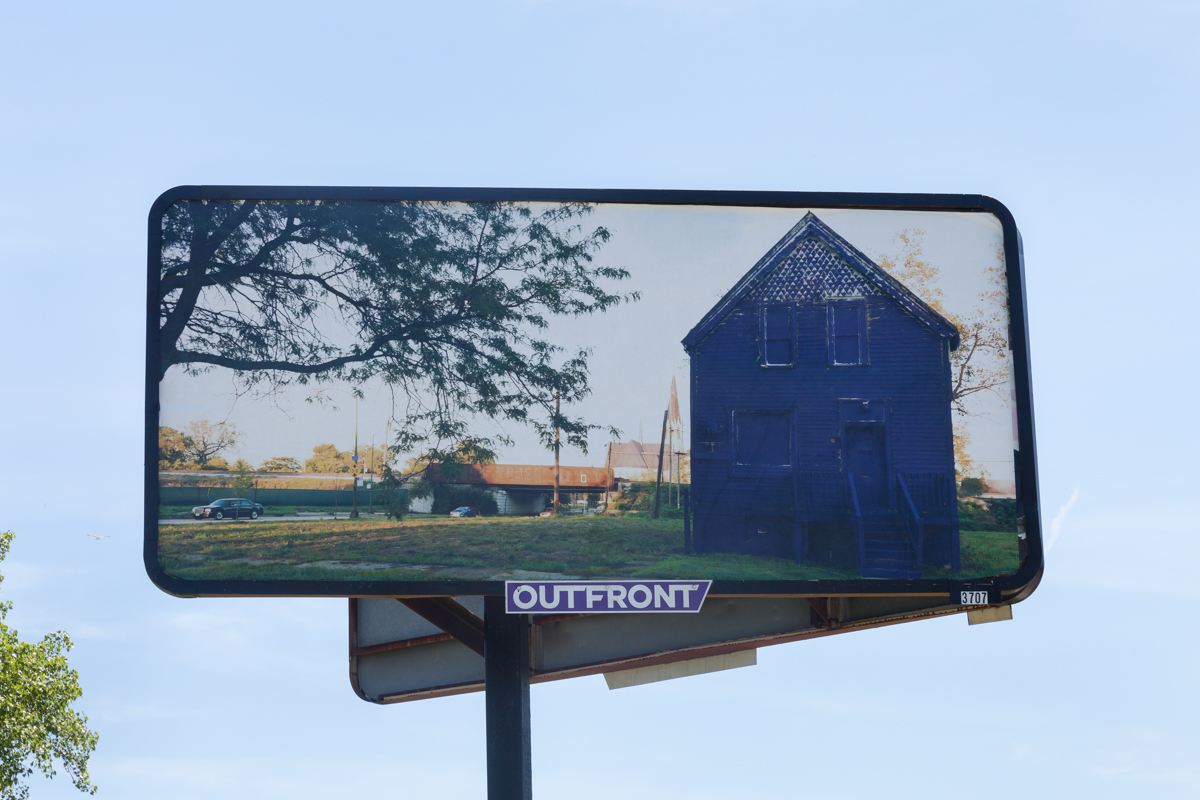
Amanda Williams, Crown Royal Purple from Color(ed) Theory, Billboard located at 1130 E 63rd Street, Chicago, June 6 – July 11, 2016, as part of In the beginning, sometimes I left messages in the street, curated by Allison Glenn.
CP: The artist installations created a conceptual link between parts of the city that often don’t connect, but you also organized walks that embodied that connection for participants. What were some of the logistics involved?
AG: I really appreciate you noticing the conceptual link, as this is something I hoped was communicated to the audience. Accessibility was important, and the idea that a diverse audience would be able to access the sites in one day, over the course of a weekend, and at their leisure throughout the duration of the exhibition really excited me. I planned the experiential programs to coincide with particular sites, days, and interests and made sure that the billboards were placed near public-transportation options yet were also accessible to people on foot, on bikes, in a car, on a train platform, on a bus—you get the idea. In this way, the audience was challenged to locate the work and, while doing so, hopefully became invested in the dérive, the unplanned journeying through an urban environment, as coined by Guy Debord.
CP: You make reference to David Markson’s novel, Wittgenstein’s Mistress. So much of that book seems to be about the ways that language, history, and memory bog down or even limit effective communication. Are there particular works from In the beginning, sometimes I left messages in the street that circumvent that issue?
AG: Within Wittgenstein’s Mistress, the female protagonist, Kate, compulsively recollects moments in her life, literature, architecture, and the humanities in an effort to determine whether or not she is the last person left on Earth. Throughout the text, ideas are jumbled, thoughts become run-on sentences, and incomplete thoughts become facts. The crux of this cyclical narrative is that any attempt Kate makes to connect to an idea, a memory, or another human becomes seemingly impossible. Her desire to rely on her knowledge of time, space, and history, along with her inability to grasp anything concrete, creates a novel with no resolve. While it lacks crescendo, the text ultimately continues to build.
The impossibility that Kate experienced within Markson’s text inspired me. I was interested in framing the exhibition around the concepts that the book foregrounds because I saw them as an opportunity to create a parallel relationship between Kate’s frustration with time and memory and the challenge with how histories are written to exclude so many artists, curators, ideas, and concepts from the canon of art history. It may be that Kate cannot place herself in the world at all because the language she is using does not allow her access to it. In a similar fashion, all of the artists who participated in the exhibition address in their works the shortcomings and fallacies within much of the language and histories that have been provided.
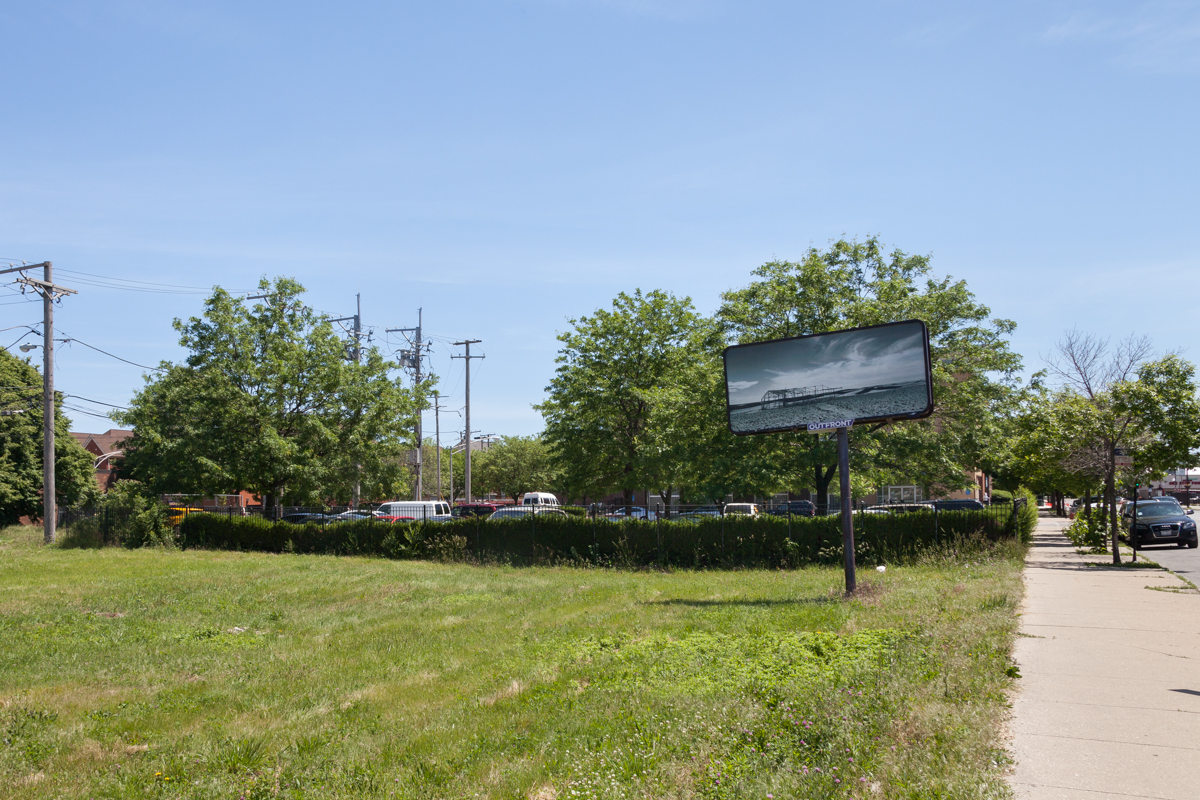
The Black Athena Collective, Assemblage, Billboard located at 1010 E. 43rd Street, Chicago, June 6 – July 11, 2016, as part of In the beginning, sometimes I left messages in the street, curated by Allison Glenn.
CP: With this exhibition, you’re able to draw out some seemingly tireless and invisible structures that have shaped not only the art historical canon but also everyday life. Does that relate to your decision to install the show around different parts of the city?
AG: The decision to position the exhibition at sites across the city, within neighborhoods that many might not normally traverse, was a response to the first line of the book: “In the beginning, sometimes I left messages in the street.” Kate left messages in the street in an attempt to communicate with an audience she could not find but wanted to engage with. The usage of billboards and their content are a metaphor for Kate’s messages.



